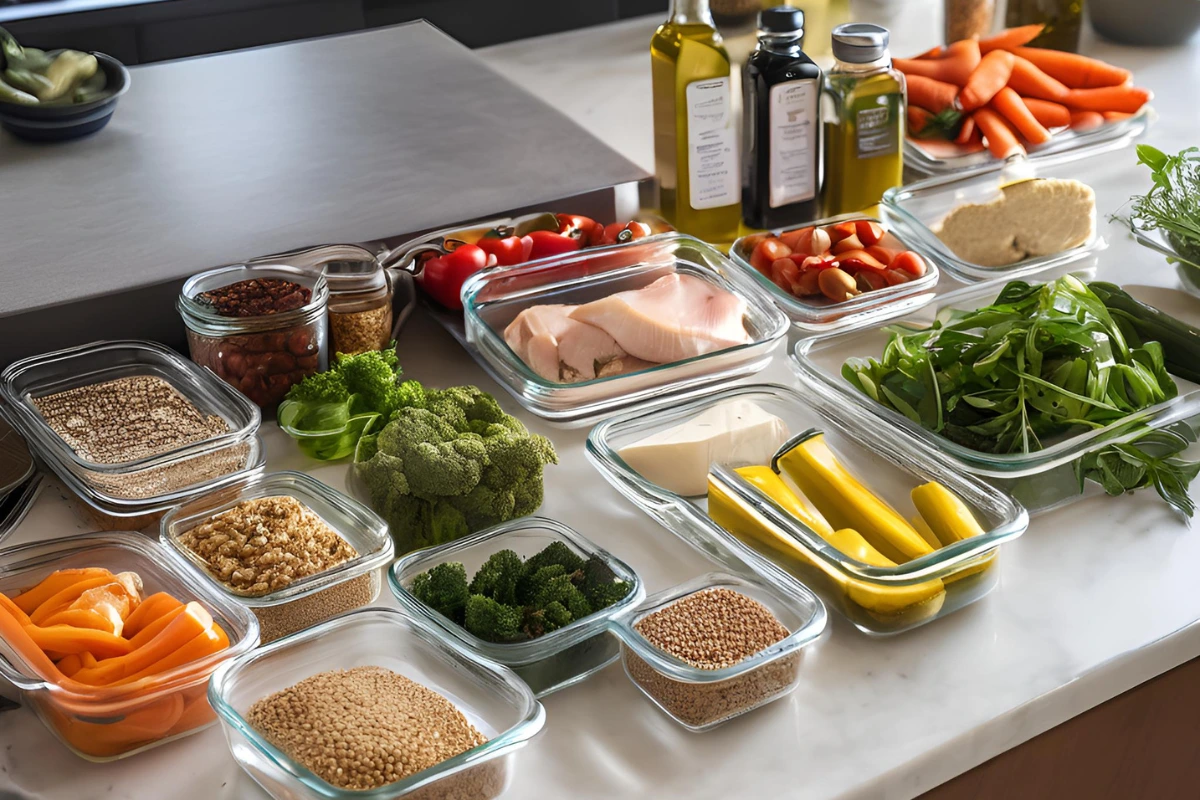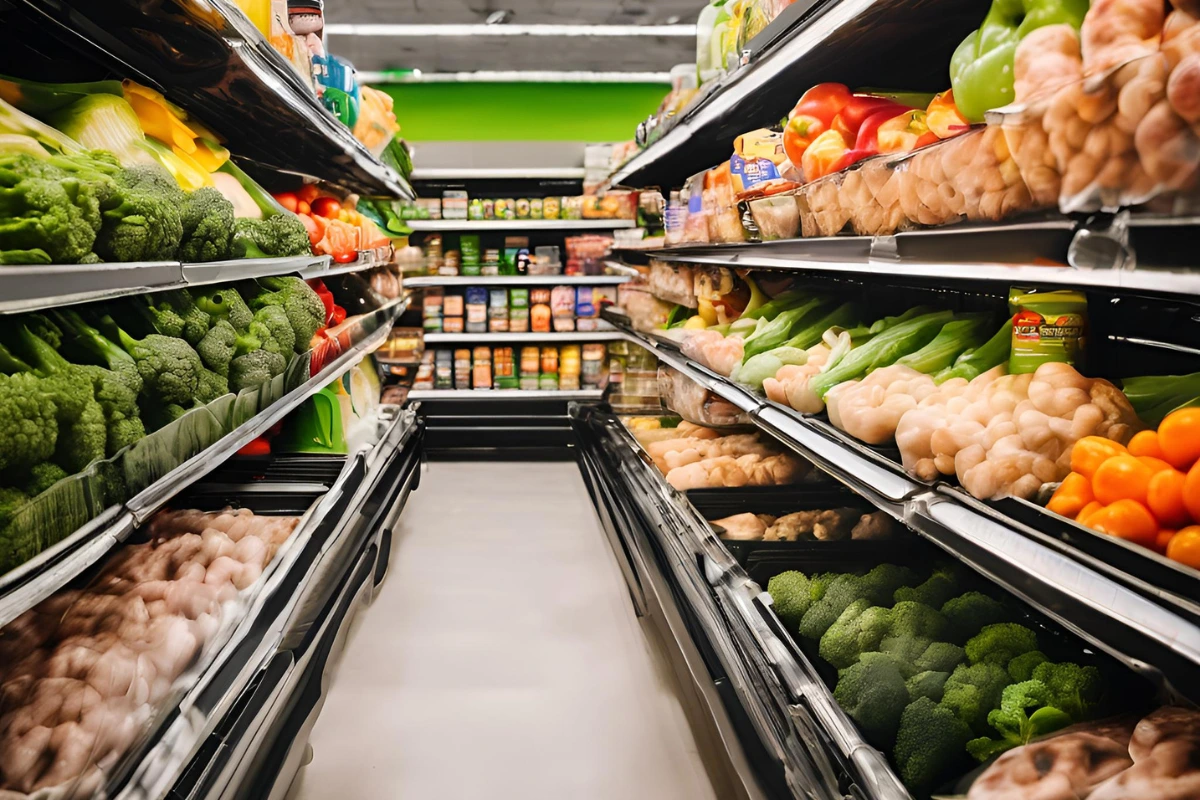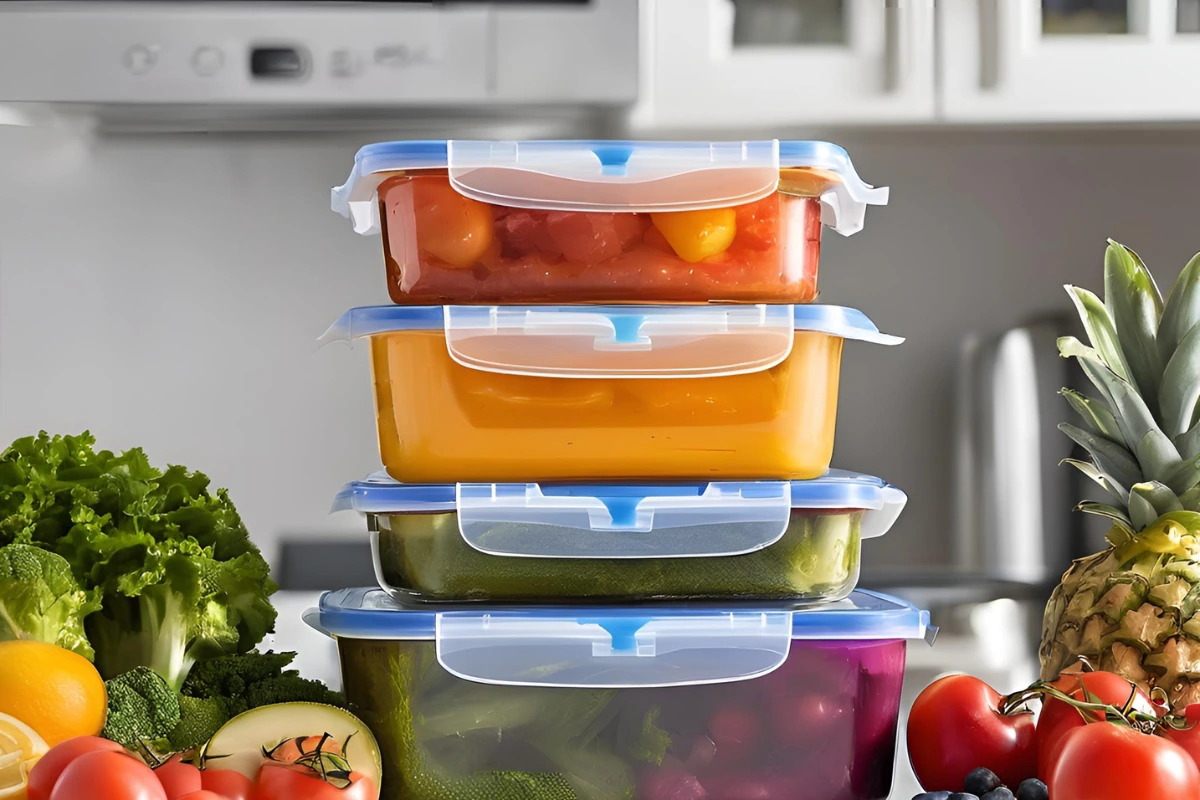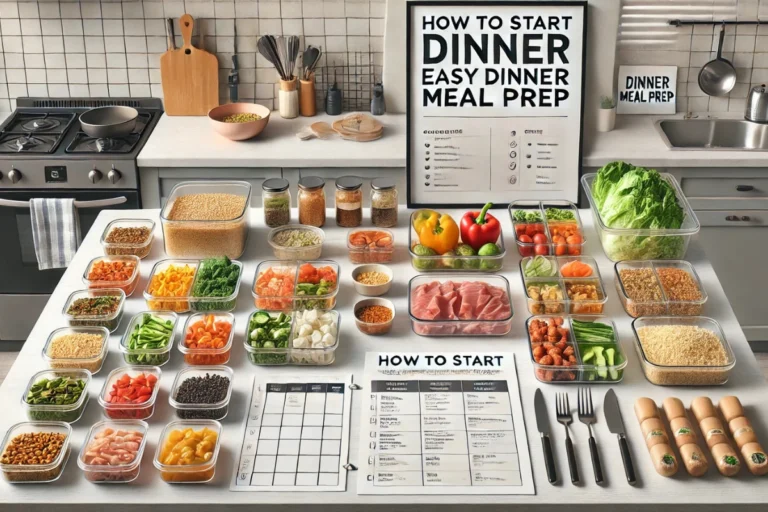You’ve heard the buzz about meal prepping, but you’re not quite sure where to start. Don’t worry, you’ve come to the right place! This comprehensive guide will walk you through the process of how to start easy dinner meal Prep: a step-by-step guide. Get ready to unlock the secrets of stress-free weeknight meals, healthier eating habits, and significant time and money savings. Let’s dive in!
Table of Contents
Why Meal Prep Dinners?
Before we get into the nitty-gritty, let’s explore why meal prepping your dinners is a game-changer:
- Save Time: With your meals prepped and ready to go, you can wave goodbye to those chaotic weeknight scrambles. No more last-minute takeout runs or stressful kitchen marathons after a long day.
- Eat Healthier: By planning and preparing your meals in advance, you have complete control over the ingredients and portion sizes. This makes it easier to stick to your dietary goals and fuel your body with nutritious, balanced meals.
- Reduce Food Waste: Meal prepping helps you plan your grocery shopping more efficiently, minimizing the risk of letting fresh produce and ingredients go to waste.
- Save Money: With a little forethought and planning, you can significantly reduce your reliance on expensive takeout and restaurant meals, saving you a pretty penny in the long run.
- Reduce Stress: No more agonizing over what to make for dinner each night. With your meals prepped and ready to go, you can enjoy a sense of calm and organization throughout the week.
Getting Started

Assess Your Needs and Preferences
Before diving into meal prep, take a moment to assess your lifestyle, dietary preferences, and any specific dietary restrictions or allergies you may have. This will help you create a meal plan that perfectly aligns with your needs and goals.
Choose Your Easy Meal Prep Style
Meal prepping isn’t a one-size-fits-all endeavor. Explore these different approaches to find the one that resonates with you:
- Full Meal Prep: This involves preparing and portioning out all your meals for the week, including breakfast, lunch, dinner, and snacks.
- Partial Meal Prep: If you prefer a little more flexibility, you can opt to prep only certain meals, like lunches or dinners, for the week.
- Ingredient Prep: This approach involves prepping and portioning out individual ingredients, such as chopped vegetables, cooked grains, and proteins, which you can then assemble into meals throughout the week.
Set a Realistic Schedule
Don’t overwhelm yourself, especially when you’re just starting. Choose one day a week dedicated to meal planning and prepping. As you become more comfortable with the process, you can gradually increase the number of meals you prepare in advance.
Find Inspiration
Meal planning can be daunting at first, but there are plenty of resources to help you get inspired:
- Meal Prep Websites and Blogs: Explore websites and blogs dedicated to meal prepping for a wealth of recipe ideas and tips.
- Cookbooks: Look for cookbooks specifically designed for meal prepping, batch cooking, and make-ahead meals.
- Meal Planning Apps: Several mobile apps can help streamline your meal planning and grocery shopping processes.
- Social Media: Follow food bloggers and social media channels dedicated to healthy eating and meal prep for visual inspiration and creative ideas.
Crafting Your Easy Meal Prep Plan
Prioritize Nutrient Balance
A well-rounded meal plan should include a balanced distribution of macronutrients (protein, carbohydrates, and healthy fats) across your meals. Here’s how to ensure you’re covering all the bases:
- Protein Powerhouses: Include lean proteins like chicken, turkey, fish, tofu, beans, and lentils to keep you feeling full and support muscle growth and repair.
- Carbohydrate Choices: Opt for complex carbohydrates like whole grains (brown rice, quinoa, whole-wheat pasta), starchy vegetables (sweet potatoes, corn), and fruits for sustained energy throughout the day.
- Healthy Fat Focus: Don’t shy away from healthy fats! Include sources like avocados, nuts, seeds, olive oil, and fatty fish to support brain function, hormone regulation, and cell health.
Embrace Culinary Diversity
While meal prep promotes efficiency, it doesn’t have to mean sacrificing flavor and variety. Here are some tips to keep your meals exciting:
- Global Palate: Explore different cuisines throughout the week, like Thai curries, Mexican quinoa bowls, or Mediterranean-inspired kabobs.
- Theme Days: Dedicate specific days to certain themes, like “Meatless Mondays” for vegetarian or vegan dishes, or “Taco Tuesdays” for a fun twist on a classic.
- Flavor Profile Variation: Play with different flavor profiles, such as sweet and savory combinations (balsamic glazed chicken with roasted Brussels sprouts) or spicy peanut noodle salads.
Leverage Leftovers Strategically
Leftovers can be your best friend when it comes to meal prepping. Plan meals that can be repurposed into other dishes throughout the week:
- Roasted Chicken Versatility: Leftover roasted chicken can be shredded and used in salads, wraps, quesadillas, or pasta dishes.
- Soup Stock Potential: Leftover roasted vegetables can be transformed into a delicious and nutritious soup base.
- Breakfast for Dinner: Leftover stir-fry vegetables can be scrambled with eggs and served with whole-wheat toast for a protein-packed breakfast.
Batch Cooking Efficiency
Embrace batch cooking techniques to streamline your meal prep process:
- Double Up on Grains: Cook a large pot of quinoa or brown rice on your prep day, and use it in various dishes throughout the week.
- Protein in Bulk: Bake a large batch of chicken breasts or salmon, and shred or cube the cooked protein for use in salads, wraps, or grain bowls.
- Roasted Veggie Power: Roast a large sheet pan of vegetables to have on hand for salads, side dishes, or quick vegetarian meals.
Consider Dietary Needs and Preferences
Ensure your meal Prep plan caters to your specific dietary needs and preferences, whether you’re vegetarian, vegan, gluten-free, or have any allergies. There are plenty of delicious and healthy meal prep options available for every dietary requirement.
Selecting Recipes and Creating Your Grocery List

Recipe Selection
When choosing recipes for your meal prep, consider the following factors:
- Prep Time: Opt for recipes that can be prepped and cooked in a reasonable amount of time during your designated meal prep day.
- Reheating Potential: Choose meals that reheat well and maintain their flavor and texture throughout the week.
- Seasonality: Take advantage of seasonal produce that’s fresh and affordable.
- Dietary Needs: Ensure all recipes cater to your dietary requirements and preferences.
- Leftover Potential: Consider recipes that can be repurposed for different meals throughout the week, like leftover roasted chicken for salads or sandwiches.
Create a Master Grocery List
Once you’ve selected your recipes, create a comprehensive grocery list:
- Consolidate Your Needs: Compile all the ingredients needed for your chosen recipes.
- Identify Staples: Stock up on pantry staples like grains, beans, spices, and healthy oils that can be used across various recipes.
- Minimize Waste: Plan your meals strategically to minimize food waste. Opt for versatile ingredients that can be incorporated into multiple dishes.
- Check the Pantry: Before heading to the store, take inventory of what you already have on hand to avoid unnecessary purchases.
Meal Prep Day: Streamlining Your Process
Prepare Your Workspace
Before you start prepping, declutter your kitchen, gather all necessary equipment (knives, cutting boards, mixing bowls), and preheat your oven if needed.
Prioritize Tasks
Start with tasks requiring the most time, such as cooking grains or proteins. Utilize multi-tasking opportunities – chop vegetables while rice cooks or prepare a marinade while chicken simmers.
Mise en Place
“Mise en place” is a French term meaning “to put in place.” This technique involves prepping all your ingredients in advance, streamlining the cooking process, and minimizing prep time.
Batch Cooking
Whenever possible, cook in bulk. For example, a large pot of quinoa can be used for lunches and side dishes throughout the week.
Portion Control
Divide your meals into individual portions for easy grab-and-go convenience. This promotes portion control and prevents overeating.
Meal Prep Storage Essentials

Proper storage is key to keeping your prepped meals fresh and delicious:
- Airtight Containers: Invest in high-quality, BPA-free airtight containers to ensure your food stays fresh and prevent leaks.
- Glass Containers: Glass containers are ideal for storing most prepped meals, as they are non-porous, stain-resistant, and microwave-safe.
- Reusable Portion Control Containers: Pre-portioned containers are perfect for lunches, snacks, and single-serving meals.
- Labels: Labeling your containers with the meal name and date helps you stay organized and avoid confusion.
Reheating and Enjoying Your Prepped Meals
Reheating Methods
The best reheating method depends on the specific meal:
- Microwave: Ideal for quick options like soups and stews.
- Oven or Stovetop: Opt for the oven or stovetop for dishes that benefit from a crispy texture, such as roasted vegetables or baked chicken.
Maximizing Flavor
To add a burst of flavor to reheated meals, consider:
- Fresh Herbs: A sprinkle of fresh herbs can liven up any dish.
- Citrus: A squeeze of lemon or lime juice can brighten up flavors.
- Condiments: A dollop of pesto, salsa, or yogurt can add a fresh, flavorful touch.
Adding Freshness
Complement your prepped meals with fresh elements like chopped vegetables, a side salad, or a dollop of Greek yogurt to keep things interesting and add a touch of freshness.
Don’t Forget Snacks
Prep healthy snacks like chopped veggies with hummus, portioned nuts, and seeds, or pre-cut fruit with nut butter to keep you fueled throughout the day.
Meal Prep Beyond the Basics
As you gain confidence in your meal-prepping skills, explore these advanced techniques:
Sheet Pan Meals
Utilize sheet pan meals for a fuss-free approach to cooking. Simply toss together protein, vegetables, and seasonings on a sheet pan and roast for a complete and flavorful meal.
Soups and Stews
Soups and stews are perfect for meal prepping as they reheat beautifully and freeze well, making them a hearty and comforting option for lunches and dinners.
Freezing Portions
Consider freezing some portions of your meals for later in the week. This offers additional flexibility and ensures you always have a healthy option readily available.
Embracing the Meal Prep Lifestyle
Food Spoilage
To prevent food spoilage:
- Practice Proper Storage: Ensure you’re storing your prepped meals in airtight containers and following recommended storage guidelines for different food types.
- Manage Leftovers: Plan to consume highly perishable meals earlier in the week. Freeze portions you won’t eat within a safe timeframe.
- Rotate Stock: Implement a “first-in, first-out” approach to your prepped meals, consuming older meals first to avoid spoilage.
Boredom with Repetitive Meals
To combat boredom with repetitive meals:
- Variety is Key: Plan a variety of meals throughout the week, exploring different cuisines, flavors, and textures.
- Prep Ingredients, Not Just Meals: Prepping individual components like cooked grains, roasted vegetables, or grilled proteins allows for more flexibility and customization.
- Incorporate Leftover Transformations: Get creative with leftovers! Leftover roasted chicken can be transformed into a salad, sandwich filling, or a stir-fry ingredient.
Running Out of Food
To avoid running out of food:
- Plan for Unforeseen Events: Account for potential schedule changes by prepping a couple of quick and easy backup meals that can be whipped up in a short time.
- Emergency Snack Stash: Keep a small stash of healthy snacks like nuts, seeds, or dried fruit on hand for unexpected hunger pangs.
- Embrace Flexibility: Don’t be afraid to deviate from your plan if needed. Adjust your meal plan and utilize leftovers for the following days.
Making Meal Prep Sustainable
Here are some tips to ensure meal prepping becomes a sustainable and enjoyable part of your routine:
- Find a Meal Prep Partner: Meal prepping can be more fun and motivating with a partner. Share responsibilities, swap recipe ideas, and enjoy the camaraderie.
- Clean Up as You Go: This prevents a daunting pile of dishes at the end of your prep session. Wash and put away utensils as you use them, keeping your workspace organized and minimizing post-prep cleaning.
- Invest in Meal Prep Essentials: Having high-quality containers, sharp knives, and efficient kitchen tools can make meal prep more enjoyable and efficient.
- Don’t Be Afraid to Experiment: Explore new recipes and cuisines! Embrace meal prep as an opportunity to broaden your culinary horizons.
- Celebrate Your Successes: Acknowledge your progress! Meal prepping takes commitment and effort, so celebrate your achievements and enjoy the convenience and health benefits it brings to your life.
Unleash the Power of Meal Prep
Meal prepping is a powerful tool that empowers you to take control of your health and well-being. By following these simple steps, you can create a sustainable meal prep routine that saves you time and money while promoting healthy eating habits. Remember, consistency is key. Start small, find a system that works for you, and enjoy the delicious and nutritious benefits that meal-prepping offers!
FAQs
How long do prepped meals last in the fridge?
Most prepped meals will stay fresh for 3-4 days when stored properly in airtight containers in the refrigerator. However, it’s essential to consider the specific ingredients and follow food safety guidelines. Always use your best judgment and discard any food that appears or smells spoiled.
Can I freeze prepped meals?
Absolutely! Freezing is an excellent way to extend the life of your prepped meals. Soups, stews, casseroles, and cooked grains freeze particularly well. Just be sure to cool the food completely before freezing and use airtight containers or freezer bags, leaving some headspace for expansion.
How can I make meal prepping more fun?
Meal prepping doesn’t have to be a chore! Try switching up your recipes each week, and exploring new cuisines or flavors. You can also make it a social activity by inviting friends or family members to join you. Additionally, listen to music, podcasts, or audiobooks while you prep to make the time more enjoyable.
Is meal prepping expensive?
Meal prepping can save you money in the long run by reducing your reliance on takeout and restaurant meals. However, the initial investment in quality storage containers and pantry staples may seem expensive upfront. Look for sales and bulk discounts, and remember that these items can be reused for many meal prep sessions to come.
How can I avoid getting bored with my prepped meals?
Variety is key to preventing boredom. Plan a diverse range of meals throughout the week, incorporating different cuisines, flavors, and textures. You can also prep individual components like grains, proteins, and vegetables, then mix and match them into different combinations throughout the week. Don’t be afraid to experiment with new recipes and seasonings, too!
For more simple dinner ideas, check out my Quick Pescatarian Dinners.
Looking for budget-friendly options? Try my Cheap Dinner Meal Prep.
For comforting, easy-to-prepare meals, explore my Comfort Food Meal Prep Recipes.

